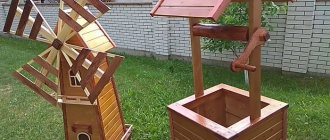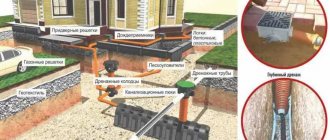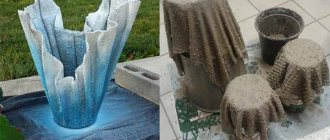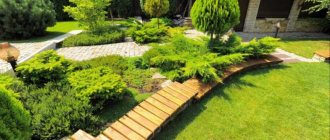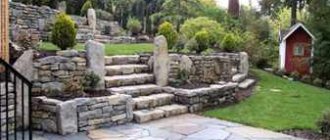In my front garden, I organized a whole flower greenhouse, planted ornamental herbs, and to dilute this design I decided to add garden decorations made of cement mortar. I’ll tell you how to make a castle with your own hands that will withstand any precipitation and will highlight the exterior of your local area for years to come.
Source na-dache.pro
Decorations for the site
There are now many options for decorating your territory :
- Entire zoos are literally built from old tires. There are swans, cats, giraffes and elephants.
- You can make flower beds and flower beds from unusable logs and stones.
- You can create figurines for the garden from polyurethane foam and bottles.
- And if you use cement and have some skills in working with it, you can create simply magnificent sculptures that will decorate any area.
You can also build a castle with your own hands from scrap materials or even build a whole kingdom that will delight not only children, but also adults. This building will add mystery to the garden, and to make it look more alive, you can make a rock garden or rock garden.
To obtain a more durable and long-lasting building, you should use a cement-sand mixture . For the composition it is better to use 2 parts sand and 1 part cement. Before starting, it is advisable to dry the sand - the drier it is, the easier it will be to sift and subsequently use.
Most often, castles are quite large in size, and besides, their construction is a little difficult. To deal with this, you can try to line up some parts separately, after which they can be easily assembled in the right place, like using cubes. Here's how to make your own castle.
Structural elements
These castles were built at different times and therefore had slightly different styles. Most often, the concept of castle architecture is associated with the Gothic style, characterized by various spiers and pointed roofs. With all the variety of styles, the characteristic structural elements of locks can be distinguished:
Figure 2. You can place a flower bed inside the castle walls.
- Hill and moat: castles were built using natural protection - a hill (hill, mountain) and were surrounded by a moat with or without water.
- Courtyard: A protected area within a fortress wall, often containing outbuildings and housing for guards and servants.
- Donjon: the central tower of the castle for the owner to live in - a fortress within a fortress; The shape of the donjon was different - quadrangular (England), round, polygonal, irregular in shape.
- Fortress wall: a high wall with battlements at the top to shelter soldiers and with loopholes.
- Defensive towers: similar to the wall, they had battlements and loopholes, most often they were round, but square shapes were also used, they were always located at the corners of the wall and in the middle part.
- Gates: to strengthen security, they were equipped with watchtowers; the entrance was usually blocked by an arch; a mandatory element was a drawbridge.
The layout of the castle territory itself depended on the terrain and had a triangular, rectangular or polygonal shape. In a number of countries (for example, Germany), a circular layout with a central courtyard without a clearly defined donjon was common.
Construction for building a castle
To build a tower from an iron sheet, you need to roll up a cylinder of the required size and fix it. It must be fixed so that it can be easily disassembled after use. To reduce the solution consumption, a bottle or jar should be placed inside the cylinder, but it must be taken into account that the thickness of the solution around the ballast should be about 5 cm.
When pouring the solution inside, make sure it is thick. After which it needs to be allowed to harden for several hours so that the formwork does not crumble when removed.
The height of the formwork should be chosen in this way: it should be approximately equal to the tower; if it is smaller, it should be disassembled and assembled above the already set part.
You can cut the solution after it has set. To perform such work, the following tools are used:
- chisel;
- screwdriver;
- scalpel or similar blade;
- blade from a hacksaw for metal;
- strips of tin that will help form the elements of the castle.
A castle made of simple cylindrical shapes will look a little boring, to avoid this you should experiment and use a chisel to imitate stonework, chips or cracks at the bottom of the castle to give the castle the effect of antiquity. Using a knife you can make windows and loopholes.
The roof is constructed from tin cones, and they can also be used as a mold for mortar. The roof should be knocked out of the mold only after the solution has reliably hardened.
Construction material
The construction of castles can be made from a wide variety of building materials, as well as improvised means. Buildings of different sizes made of stones are widespread, and both refined (marble, granite) and wild, natural stones (for example, pebbles) can be used. Such building materials are usually fixed using cement mortar, but sometimes clay, lime or gypsum compounds are used, as well as standard building mixtures.
Lanterns along the sidewalk can be decorated in the form of a tower.
Many decorative castles are built by pouring concrete. To carry out such projects, small formworks are installed. The main advantage of concrete buildings is durability, strength, moisture resistance and fire safety. For small houses, concrete reinforcement is not necessary, but for large houses, reinforcing mesh can be used.
It is difficult to do without wood when creating small architecture. Wooden parts are easy to process and can be given any shape. The need to treat with an antiseptic makes it difficult to use. Many locking elements have to be made of sheet metal, giving it a cylindrical or conical shape.
Polystyrene foam is used as a building material. This material with a dense structure, when cut, becomes small bricks for constructing a building or blocks that form an entire wall. You can use different types and sizes of plastic. Various available materials are widely used - bottles, pipe cuttings, parts of old household appliances, etc. It is difficult to list all the materials that are used in construction; it all depends on the imagination of the performer.
Mortise models
Most believe that this type of lock is one of the most convenient to use. A recess is cut into the gate where the lock is installed.
Key access on some models is possible on both sides, while the reverse part may have an additional latch. This mechanism enhances the door's protection against unwanted intrusion at night. A combination lock for a gate in this design is also possible, although it is not so common.
The recess serves as a means to protect the lock from sunlight, rain and other precipitation. Installation inside the gate frame does not allow attackers to mechanically influence it.
When buying such a model, pay attention to the number of grooves that this model has, as well as its security against burglary. If we touch on the shortcomings, they are as follows:
- There is no way to install this lock without a technician;
- Often the lock is installed along with the door. Some locks cut into a special container, and in the future you will have to rely on it.
Prices for these models differ in the composition of parts, the number of grooves and the complexity of protection from external influences and from burglary.
Caring for a stone flower bed
Artificial analogues require less subsequent care than natural formations.
For natural rocks, there are hydrophobic impregnations that prevent negative manifestations (destruction, peeling, contamination), and varnishes that add dullness or shine, as well as increase resistance to ultraviolet radiation. The organic active substances contained in them penetrate the surface of the stone by capillary action, reduce the absorption capacity, and reveal a rich color and pattern. Before processing, you should use only professional detergents (for example, from AKEMI) to remove dirt and salt deposits. You need to act strictly following the recommendations given by the manufacturer.
To make it easier to care for individual flowers, they are sometimes placed in containers or in removable structures that serve as additional decorative elements
When filling with gravel, coarse crushed stone, or pebbles, it is also useful to sometimes arrange “baths” by collecting and rinsing the pebbles in a solution of biocides that destroy organic matter. They “sweep” the stone embankment with special equipment - a blower.
A man-made structure must be inspected annually for possible damage, cracking, and timely repairs and strengthening must be carried out.
Which locking mechanism is suitable for installation on a gate or wicket?
The following types of locks are installed on garage and fence doors:
- latch;
- latch;
- bolt;
- vertical stop;
- locking systems with levers and swivel posts.
Requirements for locking mechanisms:
- burglary resistance;
- they must withstand heavy loads, including mechanical ones;
- The bolt should fit into the latch tightly, without gaps.
To firmly fix the leaves to the gate frame, levers, latches, and pressing locks are most often used. Fixed to the lower part (threshold) and the upper beam. The gate will not move in strong winds, and what is happening outside the gate will not be visible.
For swing gates and gate leaves, a vertical latch would be a good option. It is a metal rod with a handle that is inserted into a hole in the ground. Firmly fixes the blade in the closed position.
A vertical latch is also used on mortise sashes, but of a smaller size. At the top and bottom of the opening, metal pieces of pipes are welded into which the bolt rods will go.
To fix small wooden or metal gates under vertical locks, a hole is made in the ground, a piece of pipe is inserted, and fixed around it with cement mortar. Double-sided latches can be installed.
Horizontal overhead valves are popular. They are suitable for any type of gates and doors. The latch is made of a metal rod or plate. There is a locking ear holder. The operating principle is similar to the vertical latch.
On sale there is a lock NOEZ ZK-230-S specifically for street gates.


